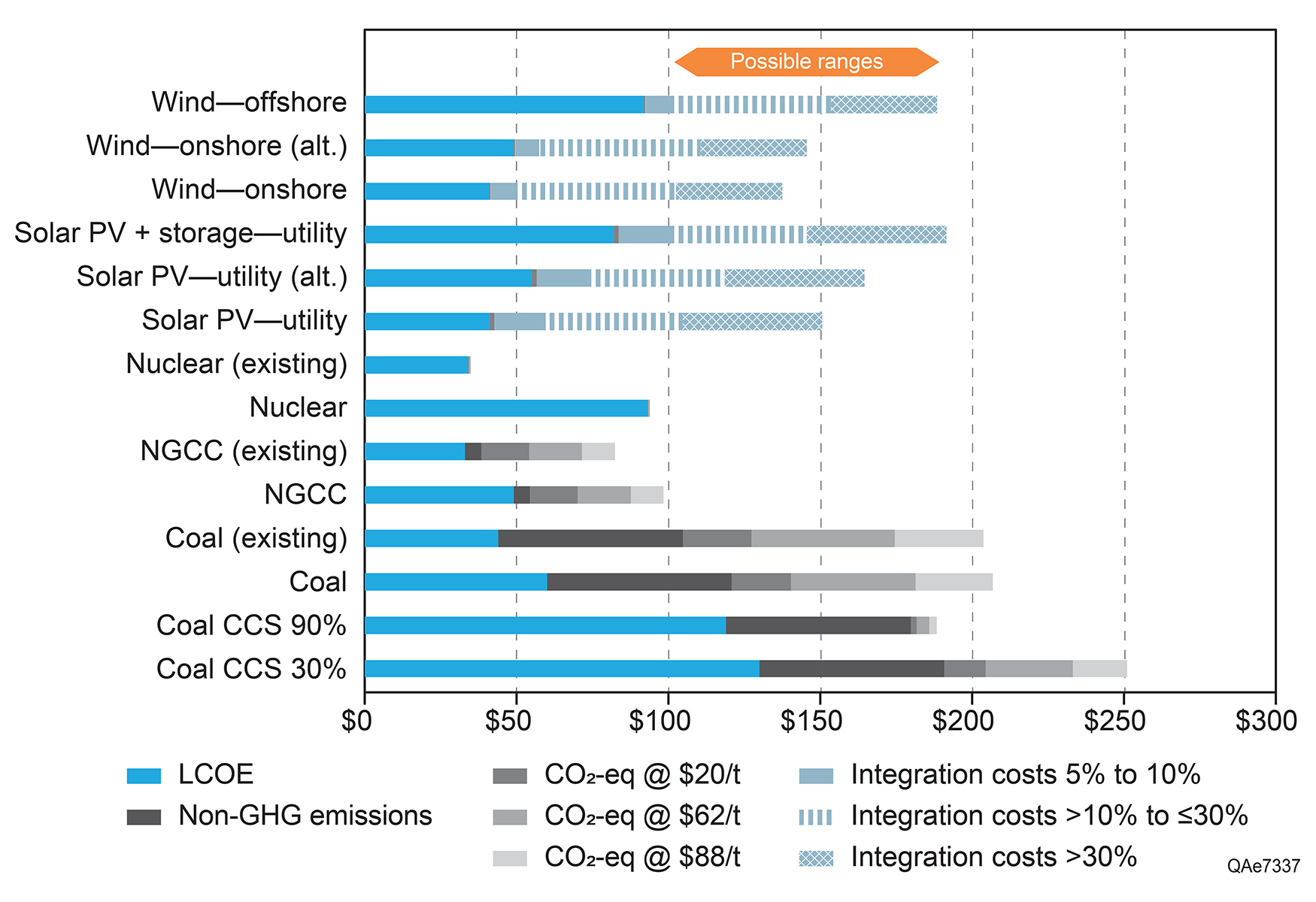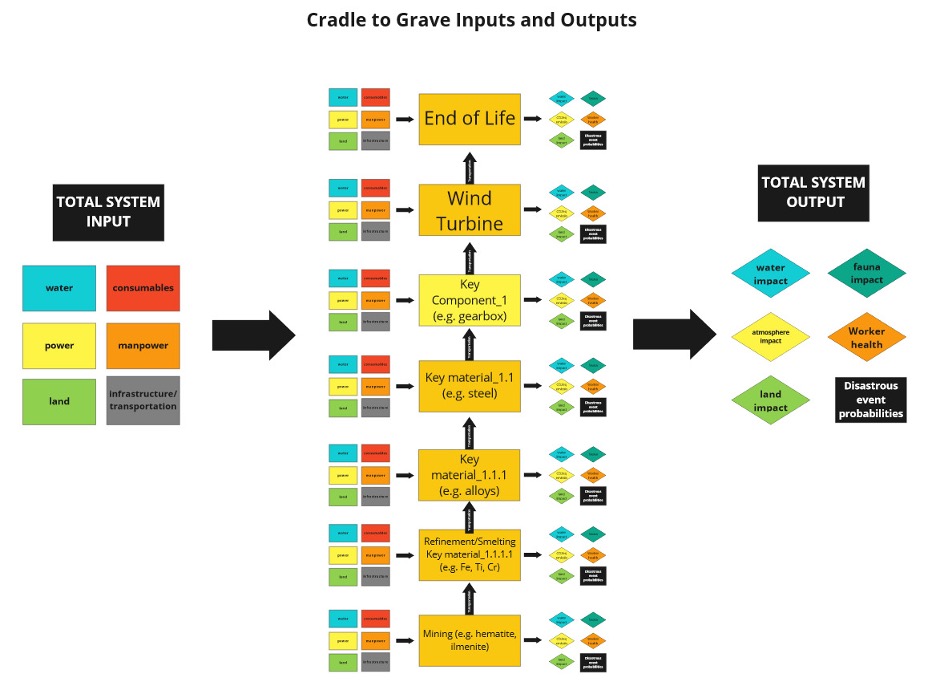Comparing Electricity Options
What is the specific problem this research addresses?
Globally, the energy transition away from greenhouse gas (GHG)–intense, carbon-based fuels and toward more sustainable and renewable energy is generally accepted as a means to mitigate impacts of climate change. However, a societal shift in electricity generating technologies is extremely complex at global scale, involving a number of uncertainties that need to be addressed to avoid negative unintended consequences. Demand for minerals such as lithium, graphite, cobalt, copper, rare earths, and nickel, which are necessary for manufacturing wind, solar, and battery equipment, is expected to grow 7 to 40 times between 2020 and 2040 (IEA, 2021). The literature on this transition includes life cycle analyses (LCAs) conducted on various electricity generation technologies, such as natural gas combined cycle gas turbines, wind turbines, and solar panels, as well as electricity storage technologies (batteries). These LCAs track potential environmental impacts along the supply chain of these technologies. However, the literature primarily focuses on GHG emissions during operations, often ignoring other environmental impacts that occur during operations and especially within the international upstream supply chains. These incomplete LCA analyses, lacking cradle-to-grave impacts, can distort the full picture of these unintended impacts from the global energy transition. This research increases the scope and flexibility of LCA modeling related to electricity generation in specific geographical areas of interest by including local and global supply chains and their potential impacts.
Why is researching this problem important?
Transitioning energy grids from carbon-based fuel sources to renewable sources will be a unique optimization exercise for each location. The economics and efficiency of various energy sources (wind, sunlight, gas) often depend on local environmental factors, and the various energy systems themselves will affect local environments differently. For example, building solar farms in a desert environment in west Texas imparts a different impact than if that same solar facility were constructed in a forest environment in northeast Texas. Another example, combined cycle gas turbines can be placed in many locations but require fuel that is extracted in specific oil and gas fields. How do we think about the environmental implications of the transport of fuel (or critical materials) from extraction to use? In some cases, the wider set of environmental impacts may be significant for communities hosting mining, manufacturing, or energy facilities. Moreover, the delivered cost of electricity may be higher than expected for renewable energy systems given the need for transmission grid expansion and dispatchable storage or backup generation. This study takes a holistic approach to the LCA method to include the entire supply chain for each energy technology and plausible future generation portfolios.
The study’s goals are to (1) provide the public, businesses, and policymakers with quantifiable information on potential impacts, (2) support analyses that determine the most affordable and environmentally optimal energy mix for specific locations, and (3) identify where innovation, efficiency, and technology can lead to a better balance of consistent availability of electricity and sustainable environmental resources.
What value will research findings have in terms of furthering related or future research?
This work will add greater dimension to the LCA method and be more data-inclusive than previous studies, providing a more holistic view and understanding of fossil and renewable energy systems. For example, we intend to include ecosystem services in the LCA, which is rarely included. Long term, this project aims to include economic projections of mineral and material supplies to help predict future costs related to increasing commodity demands, reduce supply-chain disruptions, and bolster innovation to strengthen the supply chain where possible.
What value will research findings have in terms of benefiting society in general?
Ideally, results from this project will include a flexible model that allows anyone to simulate a desired energy mix of gas, solar, wind, batteries, and other technologies not initially covered in this research, such as nuclear. Results will provide a clearer picture of total environmental impacts, local and global, including differences in upstream impacts when sourcing materials from various locations (e.g., cobalt sourced from Canada vs. Democratic Republic of the Congo vs. a new mine in the United States).
What (if any) unique approaches, processes, or technologies are being employed to this research?
This project will use meta-analyses to compile and sort through large data sets and voluminous publications to find the most relevant and up-to-date data. It will also use comprehensive global LCA databases via publicly available software platforms and data providers (e.g., openLCA and ecoinvent). Data availability and data quality for mining, manufacturing, and energy operations around the world have been recognized in the literature as a significant challenge. We expect to estimate original impact factors based on bottom-up engineering analysis or industry communication.
What related publications/information resources of importance are available regarding this area of research?
Gülen, G., 2019, Net social cost of electricity: policy smog and waning competitive markets, lack of consumer participation, importance of the grid, and scalability challenge: The University of Texas at Austin, Bureau of Economic Geology Udden Series No. 7, 86 p., doi:10.23867/US0007D.
[IEA] International Energy Agency, 2021, The role of critical minerals in clean energy transitions: International Energy Agency, World Energy Outlook Special Report series, 287 p., https://iea.blob.core.windows.net/assets/24d5dfbb-a77a-4647-abcc-667867207f74/TheRoleofCriticalMineralsinCleanEnergyTransitions.pdf.
Jordaan, S. M., 2021, Wells to wire—life cycle assessment of natural gas-fired electricity: Springer International, 115 p.
Larson, E., Greig, C., Jenkins, J., Mayfield, E., Pascale, A., and 13 others, 2021, Net-zero America—potential pathways, infrastructure, and impacts: Princeton University, final report, 348 p.
van Zalk, J., and Behrens, P., 2018, The spatial extent of renewable and non-renewable power generation—a review and meta-analysis of power densities and their application in the U.S.: Energy Policy, v. 123, p. 83–91, doi:10.1016/j.enpol.2018.08.023.

Economic and social costs of delivered electricity. From Gülen (2019).

Cradle-to-grave inputs and outputs for a wind turbine. From this study.
Research IA: Comparing Electricity Options
Project dates: Phase 1: July 2021 - December 2024
Project PIs: Dr. Michael Young (PI), Dr. Tristan Childress (Co-PI)
Other key personnel: David Chapman (project manager), Dr. Gürcan Gülen (researcher), Dr. Atta Ur Rehman (researcher), Amelia Bridges (project coordinator)
Principal information contact:
Michael Young
Email: michael.young@beg.utexas.edu
Telephone: (512) 475-8830
Tristan Childress
Email: tristan.childress@beg.utexas.edu
Telephone: (512) 471-1812
Members: Membership open. Current members Tellurian, Range Resources, Continental Resources, Marathon Petroleum, OERB
Geographic areas of study: Texas, United States, Global
General disciplines of study: Energy infrastructure, life cycle analysis (LCA), supply chain, environmental impact, energy and environmental economics, mining, resource geology
Keywords: LCA, LCI, natural gas, CCGT, wind turbine, solar panel, battery, cost comparison, energy mix, emission transition, mining